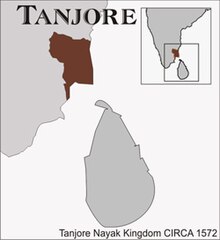217:
274:
19:
78:
in 1919, after he found it in
November 1916. The poem was fiercely criticised by an early reviewer of the first scholarly edition, who claimed that Rāmabhadrāmbā 'had thoroughly assimilated the art of composing a poem of surpassing tediousness and consisting of the most abject flattery of her royal
65:
The first few cantos of the poem invoke
Raghunatha, seeking his patronage and assistance, and praise his generosity, piety, and intellect. Canto 4 presents Raghunatha's ancestry and the subsequent cantos discuss his early life and military successes. He succeeds his father
70:
in canto 8 and continues with his military exploits. The last two cantos focus on the cultural activities and artistic achievements of his court, with a colophon in which Rāmabhadrāmbā emphasises her own merits.
79:
patron' and did not think the poem would have any interest to historians. But it has since been identified as a significant source for the cultural history of seventeenth-century south India.
75:
201:, ed. by N. Venkataramanayya and M. Somasekhara Sarma, Madras: Government Oriental Series, 49/Tanjore Saraswathi Mahal Series, 32 (Madras, 1951).
155:, ed. by S. Krishnaswami Ayyangar , The Madras University Historical Series, 1 (Madras: University of Madras, 1919), pp. 284-302 (p. 284),
111:, ed. by S. Krishnaswami Ayyangar , The Madras University Historical Series, 1 (Madras: University of Madras, 1919), pp. 284–302 ,
311:
121:, ed. by Ti. Rā. Cintāmaṇiḥ, Bulletins of the Sanskrit Department, University of Madras, 2 (: Madrapurīyaviśvavidyālayaḥ, 1934)
62:
in twelve cantos. It was designed to valorise
Raghunatha, situating his career as a type of the life of epic Rāma-Viṣṇu-Kṛṣṇa.
258:
172:. Edited by T. R. Chintamani. (Bulletins of the Sanskrit Department, No. 2.) pp. viii + 78. University of Madras, 1934.
340:
304:
185:
Velcheru
Narayana Rao, and David Shulman, 'History, Biography and Poetry at the Tanjavur Nayaka Court',
330:
297:
251:
285:
232:
45:
95:
8:
335:
156:
112:
244:
140:
Performing
Satyabhimi: Text, Context, Memory and Mimesis in Telugu-Speaking South India
67:
53:
49:
281:
228:
324:
18:
153:
Sources of
Vijayanagar History (Selected and Edited for the University)
109:
Sources of
Vijayanagar History (Selected and Edited for the University)
58:
86:
is not to be confused with the identically named Telugu poem the
273:
216:
224:
94:, both composed by Raghunatha's eldest son and successor,
142:(unpublished PhD thesis, McGill University 2004), p. 53.
170:
Raghunāthābhyudaya of Rāmabhadrāmbā (A Historical Poem)
174:
Bulletin of the School of
Oriental and African Studies
157:
https://archive.org/details/sourcesofvijayan00krisrich
113:
https://archive.org/details/sourcesofvijayan00krisrich
74:
The poem was first brought to scholarly attention by
119:
Raghunāthābhyudayamahākāvyam: Rāmabhadrāmbāviracitam
199:
Raghunāthanāyakābhyudayamu and Raghunāthābhyudayamu
176:, 7 (1935), 961-62, doi:10.1017/S0041977X00086377
322:
280:This article about the literature of India is a
305:
252:
101:
312:
298:
259:
245:
151:Rāmabhadrāmbā, 'Raghunāthābhyudayam', in
107:Rāmabhadrāmbā, 'Raghunāthābhyudayam', in
17:
323:
268:
211:
13:
14:
352:
272:
215:
192:
179:
162:
145:
132:
1:
125:
284:. You can help Knowledge by
231:. You can help Knowledge by
56:(r. 1600-34), is a Sanskrit
7:
10:
357:
267:
223:This article related to a
210:
92:Raghunāthanāyakabhyudayamu
48:, one of the wives of the
102:Editions and translations
82:Rāmabhadrāmbā's Sanskrit
90:and the similarly named
76:S. Krishnaswami Ayyangar
341:Indian literature stubs
23:
22:Tanjore Nayak Kingdom
21:
96:Vijayarāghava Nāyaka
34:Raghunāthā-bhyudayam
189:25 (1989), 115–130.
88:Raghunāthābhyudayam
84:Raghunāthābhyudayam
42:Ragunatha Abhyudaya
29:Raghunāthābhyudayam
38:Raghunāthābhyudaya
24:
331:Indian literature
293:
292:
240:
239:
168:J. C., review of
348:
314:
307:
300:
276:
269:
261:
254:
247:
219:
212:
202:
196:
190:
183:
177:
166:
160:
149:
143:
136:
68:Achuthappa Nayak
54:Raghunatha Nayak
356:
355:
351:
350:
349:
347:
346:
345:
321:
320:
319:
318:
266:
265:
208:
206:
205:
197:
193:
187:Social Analysis
184:
180:
167:
163:
150:
146:
138:Davesh Soneji,
137:
133:
128:
104:
50:Thanjavur Nayak
12:
11:
5:
354:
344:
343:
338:
333:
317:
316:
309:
302:
294:
291:
290:
277:
264:
263:
256:
249:
241:
238:
237:
220:
204:
203:
191:
178:
161:
144:
130:
129:
127:
124:
123:
122:
116:
103:
100:
9:
6:
4:
3:
2:
353:
342:
339:
337:
334:
332:
329:
328:
326:
315:
310:
308:
303:
301:
296:
295:
289:
287:
283:
278:
275:
271:
270:
262:
257:
255:
250:
248:
243:
242:
236:
234:
230:
226:
221:
218:
214:
213:
209:
200:
195:
188:
182:
175:
171:
165:
158:
154:
148:
141:
135:
131:
120:
117:
114:
110:
106:
105:
99:
97:
93:
89:
85:
80:
77:
72:
69:
63:
61:
60:
55:
51:
47:
46:Rāmabhadrāmbā
43:
39:
35:
31:
30:
20:
16:
286:expanding it
279:
233:expanding it
222:
207:
198:
194:
186:
181:
173:
169:
164:
152:
147:
139:
134:
118:
108:
91:
87:
83:
81:
73:
64:
57:
41:
37:
33:
28:
27:
25:
15:
336:Poem stubs
325:Categories
126:References
59:mahākāvya
227:is a
52:king
44:) by
282:stub
229:stub
225:poem
32:(or
26:The
327::
115:.
98:.
40:,
36:,
313:e
306:t
299:v
288:.
260:e
253:t
246:v
235:.
159:.
Text is available under the Creative Commons Attribution-ShareAlike License. Additional terms may apply.
